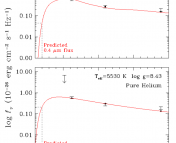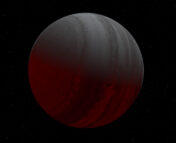Title: Discovery of a resolved white dwarf–brown dwarf binary with a small projected separation: SDSS J222551.65+001637.7AB
Authors: Jenni R. French, Sarah L. Casewell, Trent J. Dupuy, John H. Debes, Elena Manjavacas, Emily C. Martin and Siyi Xu
First Author’s Institution: University of Leicester, Leicester, United Kingdom
Status: Accepted for publication in MNRAS, available on arxiv.
When we look at our Solar System, there is a clear distinction between the mass of our Sun, a massive star that generates light using nuclear fusion, and our most massive planet, Jupiter. Jupiter, a gas giant planet, is about 1000x less massive than our Sun. The lightest stars in our Universe are red dwarfs, which are at least 80x the mass of Jupiter. Recently, astronomers have found objects in other star systems that are way heavier than Jupiter, but a lot lighter than the Sun. These objects, which lie between giant planets and low mass stars, are called brown dwarfs.
Stars are born, evolve, and die. A star like our Sun will reach its final stage of a white dwarf a few billion years into its existence (our Sun, for instance, will become a white dwarf in roughly 6 billion years). The authors of today’s paper have discovered a system called SDSS J22255+0016AB where a white dwarf and a brown dwarf orbit each other, in an intricate dance that can tell us how these objects formed and evolved to their current state.
Detecting this system
The authors found this system using the Gemini North’s Near-Infrared Imager (NIRI) camera and the Near-Infrared Spectrograph (GNIRS) from the same observatory. Figure 1 shows the two objects in a NIRI image. Using atmospheric models and the GNIRS spectra for the white dwarf, the authors derive its temperature to be 11,000 K (the Sun is ~ 6,000 K, so this is almost twice its temperature!). By comparing the brown dwarf’s spectrum to template brown dwarf spectra, they find that the brown dwarf is of L4 spectral type, with a temperature of “only” 1,800 K. Thus, the fire and ice dance! These two objects are relatively “close” to each other, at about 207 AU (or 207x further away than the Earth is from the Sun).
According to previous simulations on how the evolution of a star affects a companion’s orbit around it, this current configuration implies that the two objects were likely closer to each other when the white dwarf was in its main sequence stage – about 3x closer, in fact. Here, it appears that the brown dwarf would have been affected by stellar winds from the forming white dwarf – and the same winds carried away the white dwarf’s angular momentum, causing the increase in separation between the two objects.
It is difficult to determine whether this system formed like a regular stellar binary (i.e., both objects formed like stars, from molecular clouds) or if the brown dwarf had a planet-like formation from a disk, since the brown dwarf’s mass of 25-53 Jupiter masses could indicate that both formation scenarios are possible. The authors conclude that more observations of this system could allow for a dynamical mass calculation that can better determine its formation mechanism.
A bigger context
Thanks to the high contrast imaging instruments currently on hand, there are quite a few directly imaged exoplanets and plenty of directly imaged brown dwarfs nowadays. The authors plot the system against exoplanets and brown dwarfs that were directly imaged in Figure 2. This plot not only helps us understand a bit more about the distribution of the currently known directly imaged companions but also to place this system in a bigger context: we have mainly directly imaged objects that are at least as massive as Jupiter, and that orbit pretty far away from their stars.
Astrobite edited by Ben Cassese
Featured image credit: NOIRLab / NSF / AURA / P. Marenfeld / William Pendrill




